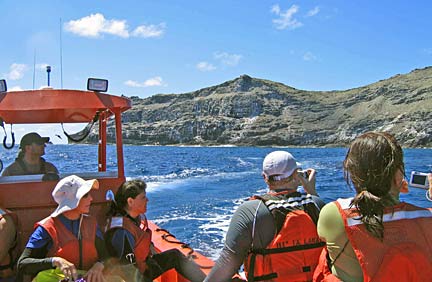|

|
Absence of algae
brings hope
ABOARD THE HI'IALAKAI » When Cindy Hunter went on an 85-foot dive near the Northwestern Hawaiian island of Mokumanamana on Sunday, the good news was that the algae wasn't there.
|
|
Isabella Abbott, a world-renowned algae expert, has studied samples brought back to her from the Northwestern Hawaiian Islands since 1997. One of the ways she gets the samples is via National Marine Fisheries Service research to see how the lobster population is doing.
Abbott first saw hookweed taken from Mokumanamana lobster pots in 2000, but the profusion of it in June alarmed her. Hookweed has not been seen elsewhere in the Northwestern Hawaiian Islands.
So Abbott asked Randy Kosaki, research director for the Northwestern Hawaiian Islands Coral Reef Ecosystem Reserve, to investigate the presence of the alien algae at Mokumanamana. Kosaki asked Hunter, a coral specialist who also knows her algae, to take a look during the current 10-day voyage for teachers to the Northwestern Islands by the National Oceanic and Atmospheric Administration.
Abbott was concerned about how much of the invasive plant had accumulated in just 12 hours underwater.
So on Saturday Hunter prepared the teachers aboard the Hi'ialakai for her dive, explaining how hookweed costs Maui County and hotel and condo owners millions over the years to remove rotting mats of the stuff from Kihei beaches.
"It was like a detective game," Hunter said in describing her Sunday dives. "We really looked but we found nothing."
While that does not guarantee the unwanted algae is not spreading, it at least lowers the volume on the alarm bell.
"I don't think that means we need to scour the area for the missing hypnea, but we do need to keep an eye out for invasives -- algal and invertebrate -- up there," Hunter said of the Northwestern Islands Coral Reef Ecosystem Reserve, which encompasses federal waters out to 50 miles from the islands.
The next scientific cruise to the area later this month will have an algae expert on board who will be watching for evidence of hookweed, Hunter said.
However, the results of Hunter's dive yesterday were not all good news. In a routine reading of his dive watch on the dive, Hi'ialakai Lt. Cmdr. John Caskey got a water temperature reading of 82 degrees at 82 feet deep.
That is pretty warm, but whether it will lead to widespread coral bleaching remains to be seen. Bleaching is the effect when tiny symbiotic algae that live inside live coral leave or die, leaving the coral animal without its main source of food.
When corals bleach, they turn white because the algae that were living in them give them their color. A rise in temperature or disease can cause bleaching.
In 2002 and 2004 voyages to the Northwestern Hawaiian Islands, scientists noted significant bleaching of coral that coincided with periods of warmer water temperatures. Coral are so sensitive they can bleach when temperatures vary by just a few degrees from what they are accustomed to.
Alien algae species
There are five alien algae species that are causing the most problems in the main Hawaiian Islands: |
E-mail to City Desk
[News] [Business] [Features] [Sports] [Editorial] [Do It Electric!]
[Classified Ads] [Search] [Subscribe] [Info] [Letter to Editor]
[Feedback]
